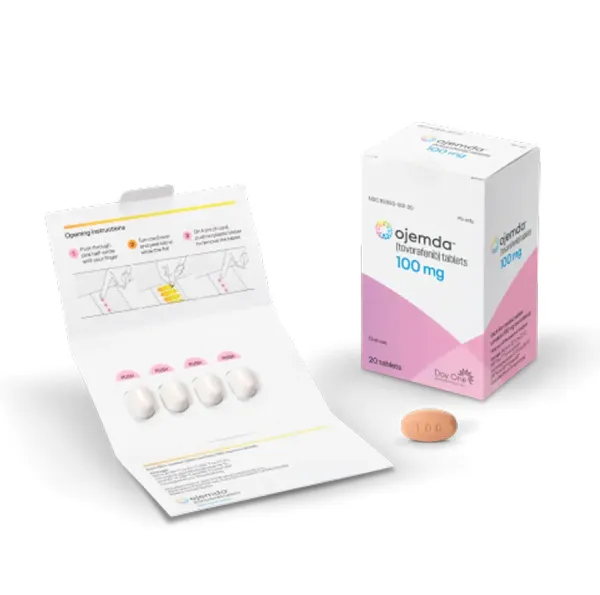Ojemda Side Effects
Generic name: tovorafenib
Medically reviewed by Drugs.com. Last updated on Nov 10, 2024.
Note: This document provides detailed information about Ojemda.
Applies to tovorafenib: oral oral suspension, oral tablets Side Effects associated with tovorafenib. Some dosage forms listed on this page may not apply specifically to the brand name Ojemda.
Applies to tovorafenib: oral oral suspension, oral tablets.
Side effects include:
Adverse effects (≥30%): rash, hair color changes, fatigue, viral infection, vomiting, headache, hemorrhage, pyrexia, dry skin, constipation, nausea, dermatitis acneiform, upper respiratory tract infection.
For healthcare professionals
Applies to tovorafenib: oral suspension, oral tablet.
General adverse events
The most frequently reported side effects included constipation, acneiform dermatitis, dry skin, fatigue, hair color changes, headache, hemorrhage, nausea, pyrexia, rash, upper respiratory tract infection, viral infection, and vomiting.
The most frequently reported grade 3 or 4 laboratory abnormalities included decreased albumin, decreased hemoglobin, decreased leukocytes, decreased lymphocytes, decreased phosphate, decreased potassium, decreased sodium, increased ALT, increased AST, and increased creatine phosphokinase.[Ref]
Cardiovascular
- Very common (10% or more): Hemorrhage (42%)[Ref]
Hemorrhage included anal hemorrhage, gastrointestinal epistaxis, gingival bleeding, hemoptysis, intracranial tumor hemorrhage, lower gastrointestinal hemorrhage, post procedural hemorrhage, subdural hemorrhage, tumor hemorrhage, upper gastrointestinal hemorrhage, and vaginal hemorrhage.[Ref]
Dermatologic
- Very common (10% or more): Dermatitis acneiform (31%), dry skin (36%), hair color changes (76%), paronychia (26%), photosensitivity (12), pruritus (26%), rash (77%)
- Frequency not reported: Skin toxicity[Ref]
Rash included dermatitis, dermatitis bullous, drug eruption, eczema, multiforme erythema, erythematous rash, follicular rash, macular rash, maculopapular rash, popular rash, pruritic rash, pustular rash, and skin exfoliation.
Skin toxicity included photosensitivity.[Ref]
Gastrointestinal
- Very common (10% or more): Abdominal pain (28%), constipation (33%), diarrhea (22%), nausea (33%), stomatitis (20%), vomiting (50%)[Ref]
Vomiting included hematemesis and retching.
Diarrhea included colitis and enterocolitis.
Stomatitis included aphthous ulcer, cheilitis, mouth ulceration, and mucosal inflammation.[Ref]
Hematologic
- Very common (10% or more): Decreased hemoglobin (90%), decreased leukocytes (31%), decreased lymphocytes (50%), increased lymphocytes (23%)[Ref]
Hepatic
- Very common (10% or more): Increased AST (83%), increased ALT (50%), increased bilirubin (22%)
- Frequency not reported: Hepatotoxicity[Ref]
Metabolic
- Very common (10% or more): Edema (26%)[Ref]
Edema included face edema, lip edema, localized edema, periorbital edema, peripheral edema, and vulval edema.[Ref]
Musculoskeletal
- Frequency not reported: Reductions in growth velocity[Ref]
Nervous system
- Very common (10% or more): Headache (45%)[Ref]
Other
- Very common (10% or more): Decreased albumin (24%), decreased phosphate (87%), decreased potassium (51%), decreased sodium (20%), fatigue (55%), increased creatine phosphokinase (83%), increased LDH (73%), pyrexia (39%), viral infection (55%)
- Common (1% to 10%): Sepsis[Ref]
Viral infection included adenovirus infection, adenoviral upper respiratory infection, coronavirus infection, COVID-19, enterovirus infection, gastroenteritis viral, herpes simplex, influenza, influenza like illness, metapneumovirus infection, oral herpes, parainfluenza virus infection, parvovirus infection, rhinovirus infection, respiratory syncytial virus bronchiolitis, respiratory syncytial virus infection, SARS-COV-2 test positive, viral conjunctivitis, viral enterocolitis, viral eye infection, viral pharyngitis, viral respiratory tract infection, viral rhinitis, viral tonsillitis, viral upper respiratory tract infection, and viremia.
Increased creatine phosphokinase was a clinically important laboratory abnormality that worsened from baseline in patients treated with this drug.[Ref]
Respiratory
- Very common (10% or more): Upper respiratory tract infection (31%)
- Common (1% to 10%): Pneumonia[Ref]
See also:
References
1. (2024) "Product Information. Ojemda (tovorafenib)." Day One Biopharmaceuticals, Inc.
More about Ojemda (tovorafenib)
- Check interactions
- Compare alternatives
- Pricing & coupons
- Drug images
- Dosage information
- During pregnancy
- FDA approval history
- Drug class: multikinase inhibitors
- En español
Patient resources
Professional resources
Related treatment guides
Further information
Ojemda side effects can vary depending on the individual. Always consult your healthcare provider to ensure the information displayed on this page applies to your personal circumstances.
Note: Medication side effects may be underreported. If you are experiencing side effects that are not listed, submit a report to the FDA by following this guide.

